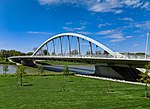Rich Street Bridge
2012 establishments in OhioBridge (structure) stubsBridges completed in 2012Bridges in Columbus, OhioBridges of the United States Numbered Highway System ... and 3 more
Bridges over the Scioto RiverColumbus, Ohio stubsU.S. Route 62

The Rich Street Bridge is a bridge in Columbus, Ohio, United States, spanning the Scioto River and connecting downtown's Rich Street to Franklinton's Town Street. It carries U.S. Route 62 (US 62) and Ohio State Route 3 (SR 3). The bridge was completed in 2012.The bridge replaced the Town Street Bridge (1917-2009). The original eastern anchor remains, reutilized as the Prow, an observation platform in the Scioto Mile Promenade park. The site features stone benches, lanterns, and a grove of birch trees.
Excerpt from the Wikipedia article Rich Street Bridge (License: CC BY-SA 3.0, Authors, Images).Rich Street Bridge
West Town Street, Columbus
Geographical coordinates (GPS) Address External links Nearby Places Show on map
Geographical coordinates (GPS)
| Latitude | Longitude |
|---|---|
| N 39.957444444444 ° | E -83.005083333333 ° |
Address
Rich Street Bridge
West Town Street
43216 Columbus
Ohio, United States
Open on Google Maps











